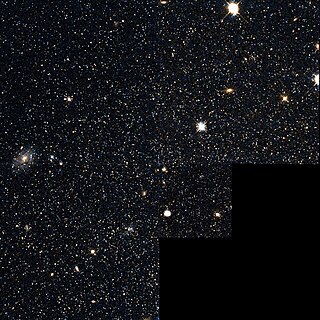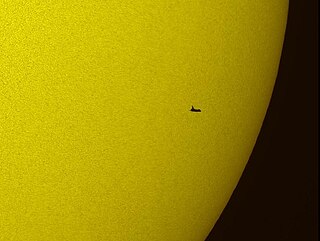
Amateur astronomy is a hobby where participants enjoy observing or imaging celestial objects in the sky using the unaided eye, binoculars, or telescopes. Even though scientific research may not be their primary goal, some amateur astronomers make contributions in doing citizen science, such as by monitoring variable stars, double stars, sunspots, or occultations of stars by the Moon or asteroids, or by discovering transient astronomical events, such as comets, galactic novae or supernovae in other galaxies.

The Andromeda Galaxy is a barred spiral galaxy and is the nearest major galaxy to the Milky Way. It was originally named the Andromeda Nebula and is cataloged as Messier 31, M31, and NGC 224. Andromeda has a D25 isophotal diameter of about 46.56 kiloparsecs (152,000 light-years) and is approximately 765 kpc (2.5 million light-years) from Earth. The galaxy's name stems from the area of Earth's sky in which it appears, the constellation of Andromeda, which itself is named after the princess who was the wife of Perseus in Greek mythology.

Astrophotography, also known as astronomical imaging, is the photography or imaging of astronomical objects, celestial events, or areas of the night sky. The first photograph of an astronomical object was taken in 1840, but it was not until the late 19th century that advances in technology allowed for detailed stellar photography. Besides being able to record the details of extended objects such as the Moon, Sun, and planets, modern astrophotography has the ability to image objects outside of the visible spectrum of the human eye such as dim stars, nebulae, and galaxies. This is accomplished through long time exposure as both film and digital cameras can accumulate and sum photons over long periods of time or using specialized optical filters which limit the photons to a certain wavelength.

Andromeda is one of the 48 constellations listed by the 2nd-century Greco-Roman astronomer Ptolemy, and one of the 88 modern constellations. Located in the northern celestial hemisphere, it is named for Andromeda, daughter of Cassiopeia, in the Greek myth, who was chained to a rock to be eaten by the sea monster Cetus. Andromeda is most prominent during autumn evenings in the Northern Hemisphere, along with several other constellations named for characters in the Perseus myth. Because of its northern declination, Andromeda is visible only north of 40° south latitude; for observers farther south, it lies below the horizon. It is one of the largest constellations, with an area of 722 square degrees. This is over 1,400 times the size of the full moon, 55% of the size of the largest constellation, Hydra, and over 10 times the size of the smallest constellation, Crux.

The Hubble Deep Field (HDF) is an image of a small region in the constellation Ursa Major, constructed from a series of observations by the Hubble Space Telescope. It covers an area about 2.6 arcminutes on a side, about one 24-millionth of the whole sky, which is equivalent in angular size to a tennis ball at a distance of 100 metres. The image was assembled from 342 separate exposures taken with the Space Telescope's Wide Field and Planetary Camera 2 over ten consecutive days between December 18 and 28, 1995.

David Frederick Malin is a British-Australian astronomer and photographer. He is principally known for his spectacular colour images of astronomical objects. A galaxy is named after him, Malin 1, which he discovered in 1986 and which is the largest spiral galaxy so far discovered.

Messier 7 or M7, also designated NGC 6475 and sometimes known as the Ptolemy Cluster, is an open cluster of stars in the constellation of Scorpius. The cluster is easily detectable with the naked eye, close to the "stinger" of Scorpius. With a declination of −34.8°, it is the southernmost Messier object.

Messier 110, or M110, also known as NGC 205, is a dwarf elliptical galaxy that is a satellite of the Andromeda Galaxy in the Local Group.

NGC 206 is a bright star cloud in the Andromeda Galaxy, and the brightest star cloud in Andromeda when viewed from Earth.

Andromeda I is a dwarf spheroidal galaxy (dSph) about 2.40 million light-years away in the constellation Andromeda. Andromeda I is part of the local group of galaxies and a satellite galaxy of the Andromeda Galaxy (M31). It is roughly 3.5 degrees south and slightly east of M31. As of 2005, it is the closest known dSph companion to M31 at an estimated projected distance of ~40 kpc or ~150,000 light-years.

Isaac Roberts FRS was a Welsh engineer and businessman best known for his work as an amateur astronomer, pioneering the field of astrophotography of nebulae. He was a member of the Liverpool Astronomical Society in England and was a fellow of the Royal Geological Society. Roberts was also awarded the Gold Medal of the Royal Astronomical Society in 1895.
John "Jack" Borden Newton is a Canadian astronomer, best known for his publications and images in amateur astrophotography.
Steve Mandel is an amateur astronomer and astrophotographer. He owns a small observatory, called Hidden Valley Observatory, in Soquel, California. He has been acknowledged especially for his wide-field photographs of the Milky Way nebulae and for public outreach, for which he has received Amateur Achievement Award of the Astronomical Society of the Pacific. Besides this he has also captured and published wildlife images of endangered animals. He works as an American communications coach for professional executives, and is the founder of the Mandel Communications Inc., which aims to teach effective communication and public speaking.

Robert Jay GaBany is an American amateur astronomer and astrophotographer who is also known for his work with an international team of astrophysicists led by Dr. David Martínez-Delgado. GaBany helped pioneer the use of modest size telescopes and off the shelf CCD-cameras to produce long exposure images that revealed ancient galactic merger remnants in the form of star streams surrounding nearby galaxies that were previously undetected or suspected.

Rogelio Bernal Andreo is a Spanish-American astrophotographer. He is known for his photographs of deep sky objects. His work has been recognized by NASA as a regular contributor to their Astronomy Picture of the Day (APOD) 80 times. Andreo's photography has been published in international magazines and periodicals, as well as television networks including the BBC, National Geographic, and the Discovery Channel series Into the Universe with Stephen Hawking.

Astronomy Photographer of the Year is an annual astronomy photography competition and exhibition that is organised by the Royal Observatory, Greenwich.

M31-RV is a possible red cataclysmic variable star located in the Andromeda Galaxy (M31) that experienced an outburst in 1988, which is similar to the outburst V838 Monocerotis experienced in 2002. Such objects have been called luminous red novae or intermediate-luminosity red transients. During the outburst, both V838 Mon and M31-RV reached a maximum absolute visual magnitude of -9.8.

Thierry Legault is a French amateur astronomer, specializing in astrophotography.

Donatiello I, also known as Mirach's Goblin, is a dwarf spheroidal galaxy in the constellation Andromeda, located between 8.1 and 11.4 million light-years from Earth. It is a possible satellite galaxy of the dwarf lenticular galaxy NGC 404, "Mirach's Ghost", which is situated 60 arcminutes away. It is otherwise one of the most isolated dwarf spheroidal galaxies known, being separated from NGC 404 by around 211,000 light-years. The galaxy is named after its discoverer, amateur astronomer and astrophotographer Giuseppe Donatiello, who sighted the galaxy in a 2016 review of his archival long exposures from 2010 and 2013. Follow-up observations with the Roque de los Muchachos Observatory led to a scientific paper on its discovery being published in December 2018.

Adam David Block is an American astrophotographer, astronomy researcher, writer and instructor.


















